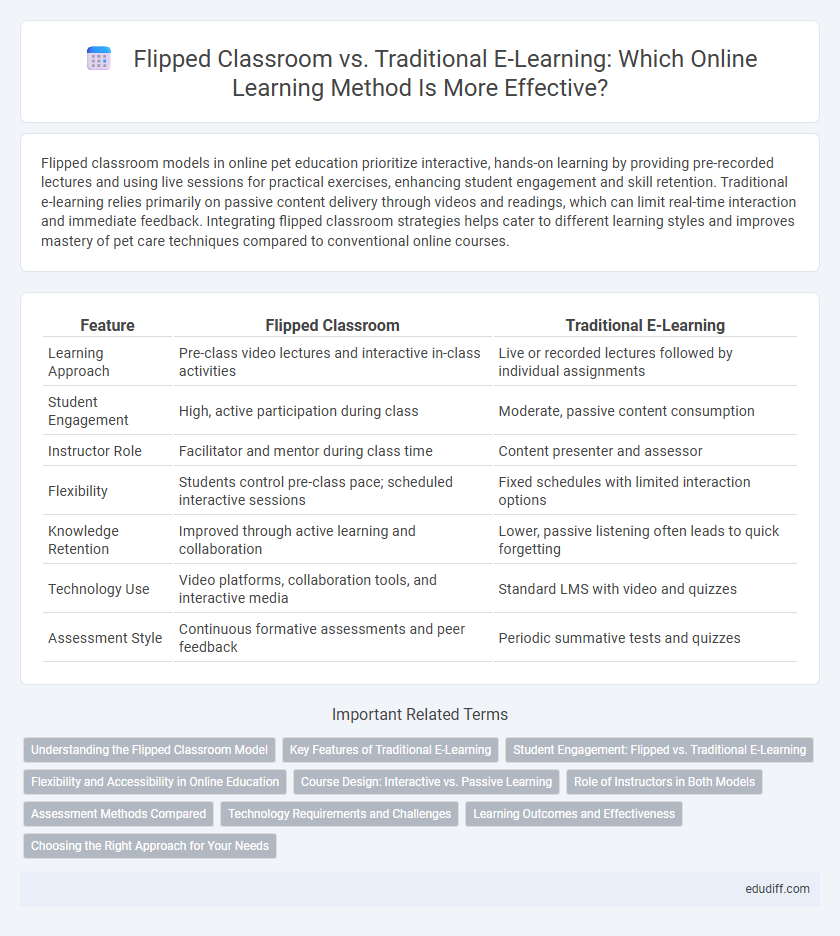Flipped classroom models in online pet education prioritize interactive, hands-on learning by providing pre-recorded lectures and using live sessions for practical exercises, enhancing student engagement and skill retention. Traditional e-learning relies primarily on passive content delivery through videos and readings, which can limit real-time interaction and immediate feedback. Integrating flipped classroom strategies helps cater to different learning styles and improves mastery of pet care techniques compared to conventional online courses.
Table of Comparison
| Feature | Flipped Classroom | Traditional E-Learning |
|---|---|---|
| Learning Approach | Pre-class video lectures and interactive in-class activities | Live or recorded lectures followed by individual assignments |
| Student Engagement | High, active participation during class | Moderate, passive content consumption |
| Instructor Role | Facilitator and mentor during class time | Content presenter and assessor |
| Flexibility | Students control pre-class pace; scheduled interactive sessions | Fixed schedules with limited interaction options |
| Knowledge Retention | Improved through active learning and collaboration | Lower, passive listening often leads to quick forgetting |
| Technology Use | Video platforms, collaboration tools, and interactive media | Standard LMS with video and quizzes |
| Assessment Style | Continuous formative assessments and peer feedback | Periodic summative tests and quizzes |
Understanding the Flipped Classroom Model
The flipped classroom model reverses traditional e-learning by delivering instructional content online before class, allowing in-person sessions for active learning and collaboration. This approach enhances student engagement and comprehension by emphasizing problem-solving and application rather than passive content reception. Research indicates that flipped classrooms improve retention rates and foster deeper understanding compared to conventional e-learning methods.
Key Features of Traditional E-Learning
Traditional e-learning primarily relies on structured, instructor-led courses delivered through Learning Management Systems (LMS) with pre-recorded lectures and standardized assessments. It emphasizes linear content progression, scheduled deadlines, and minimal learner interaction, fostering a more passive learning experience. Key features include fixed pacing, centralized content delivery, and limited opportunities for personalized or interactive engagement.
Student Engagement: Flipped vs. Traditional E-Learning
Flipped classrooms significantly enhance student engagement by fostering active participation through pre-class video lectures and interactive in-class activities, contrasting with traditional e-learning's passive content consumption. Studies show flipped models increase time-on-task and collaborative learning, leading to higher retention and motivation. Traditional e-learning often suffers from lower engagement levels due to limited real-time interaction and one-way information delivery.
Flexibility and Accessibility in Online Education
Flipped classroom models enhance flexibility by allowing students to access lecture materials anytime, promoting self-paced learning that adapts to individual schedules. Traditional e-learning platforms often follow fixed schedules and live sessions, which can limit accessibility for learners in different time zones or with varying commitments. Accessibility in flipped classrooms is further improved through diverse multimedia resources, ensuring content is available across multiple devices without real-time constraints.
Course Design: Interactive vs. Passive Learning
Flipped classroom course design emphasizes interactive learning through pre-class multimedia content and in-class active engagement, fostering deeper understanding and critical thinking. Traditional e-learning often relies on passive content delivery such as recorded lectures and reading materials, limiting student interaction and engagement. Incorporating interactive elements like quizzes, discussions, and collaborative projects in flipped classrooms enhances learner retention and motivation compared to the more static traditional approach.
Role of Instructors in Both Models
In the flipped classroom model, instructors act primarily as facilitators, guiding students through active learning and personalized support during in-class activities after students engage with instructional content online beforehand. Traditional e-learning relies more heavily on instructors delivering content through lectures or pre-recorded materials, with limited real-time interaction and feedback. This shift in instructor roles enhances student engagement and deepens understanding in flipped classrooms compared to the more passive learning environment typical in traditional e-learning.
Assessment Methods Compared
Flipped classrooms utilize formative assessments such as quizzes and peer evaluations to provide immediate feedback and promote active learning, whereas traditional e-learning often relies heavily on summative assessments like final exams and standardized tests. The flipped model emphasizes continuous assessment to gauge understanding before class, enabling personalized instruction, while traditional e-learning assessments may lack real-time interaction and adaptation. This shift in assessment methods enhances student engagement and supports a deeper mastery of content in flipped classrooms compared to conventional e-learning environments.
Technology Requirements and Challenges
Flipped classrooms require robust technology such as reliable high-speed internet, interactive video platforms, and devices capable of streaming and content creation, which can pose accessibility challenges for some students. Traditional e-learning often relies on standard Learning Management Systems (LMS) and asynchronous content delivery, requiring less real-time interactivity, thus demanding lower bandwidth and simpler technology infrastructure. Both models face challenges in ensuring equitable access to devices and connectivity, but flipped classrooms emphasize real-time engagement tools and multimedia resources, increasing the complexity of technical requirements.
Learning Outcomes and Effectiveness
Flipped classroom models enhance learning outcomes by promoting active student engagement and allowing personalized pacing, which improves knowledge retention compared to traditional e-learning formats. Studies indicate that flipped classrooms facilitate higher critical thinking skills and better application of concepts through interactive activities, contrasting with the passive content consumption common in traditional online courses. Effectiveness metrics show increased student satisfaction and performance, making flipped classrooms a superior method for fostering deep understanding in digital education environments.
Choosing the Right Approach for Your Needs
Choosing between a flipped classroom and traditional e-learning depends on learner engagement and content complexity; flipped classrooms promote active participation by having students review materials beforehand, allowing for interactive, application-focused sessions. Traditional e-learning suits learners requiring structured content delivery with clear pacing and self-study flexibility. Assessing learner preferences, technological access, and instructional goals ensures selecting the optimal approach for effective online education outcomes.
Flipped classroom vs Traditional e-learning Infographic

 edudiff.com
edudiff.com